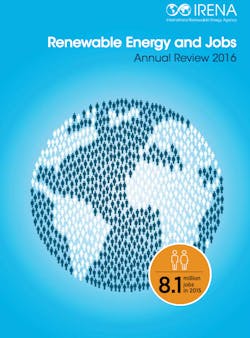The movement towards powering the United States with clean energy has grown considerably in recent years, and many jobs have been created as a result. As of December 2016, the U.S. had 2.5 million workers employed in roles related to clean energy. Of those 2.5 million workers, 1.9 million have jobs that support energy efficiency efforts. These workers are employed by more than 165,000 companies which are involved in manufacturing, selling, or installing energy-efficient heating, ventilation, and air conditioning (HVAC) equipment, lighting, ENERGY STAR™ appliances, and building materials.
The HVAC industry is the top employer in the energy efficiency sector. Every city in America has its own local HVAC companies, which create jobs that strengthen their local economy. In fact, about 70% of workers in this industry are employed by small, locally owned businesses which have 10 employees or fewer. As this industry continues to expand throughout the U.S., more people will find employment, resulting in more homes enjoying the advantages of energy-efficient HVACs and more effort being made to reduce their environmental impact.
Benefits of Energy-Efficient HVAC Systems
Air conditioning is a major source of energy consumption, responsible for approximately half the energy costs of the average U.S. household. Therefore, making HVAC systems energy efficient is a priority. Fortunately, the technology has been improved greatly in the past few decades. HVAC systems being produced today are 30-50% more efficient than those made 40 years ago. The U.S. Department of Energy also reports that replacing a home’s 12-year-old HVAC system with an ENERGY STAR-certified model could cut the household cooling costs by 30%.
As this industry continues to expand throughout the U.S., more people will find employment, resulting in more homes enjoying the advantages of energy-efficient HVACs and more effort being made to reduce their environmental impact.
These energy-efficient systems are not limited to air conditioners for homes. They also include large units for commercial buildings, heat pumps, furnaces, boilers, rooftop units, chillers (frequently used in buildings which house computer servers and other heat-producing, temperature-sensitive equipment), and packaged systems. In addition, the HVAC system includes vital components such as ductwork and air handlers, which contribute to the system’s overall efficiency. Installing and maintaining modern, energy-efficient HVAC systems in homes and commercial buildings saves energy and money by using less energy over time. It also creates many jobs, as workers are needed to manufacture, sell, install, and maintain these systems.
A Growing Supply of Jobs
The number of energy efficiency jobs continues to grow each year, but employers in the industry have reported that it can be difficult to find qualified workers for these positions. When these employers were surveyed, the most common reasons given for this worker shortage were a lack of experience, training, or technical skills. However, this means that there are many future opportunities for workers who pursue the skills, training, or certifications needed to fill these roles.
It has been estimated that the economy could add more than a million energy efficiency jobs by 2030, and up to 2 million of these jobs by 2050.
In fact, it has been estimated that the economy could add more than a million energy efficiency jobs by 2030, and up to 2 million of these jobs by 2050. Most of these job gains are expected to be in construction, manufacturing, and service sectors. These gains will outweigh the losses in fossil fuel industry jobs as the nation transitions to using greener energy sources and more efficient systems, creating a net gain in the total number of jobs.
This shift already has begun. In May 2016, the International Renewable Energy Agency (IRENA) released an annual report on renewable energy and jobs. The study showed that solar energy employment reached 209,000 workersCalifornia: America’s Leader in Energy Efficiency Employment
California is currently home to more energy efficiency jobs than any other state. The state has about 321,000 workers in this sector, and half of these workers report that the greatest share of their time is spent on energy efficiency services. About 57% of the firms represented sell or install energy-efficient systems, and the rest are involved in manufacturing or other aspects of the industry.
State policies that encourage energy efficiency have resulted in California’s long-term status as a leader in this area, improving the state’s economy and environment.
“Governors, legislators, regulators, businesses, and citizens are increasingly recognizing that energy efficiency is a critical state resource that keeps money in the local economy,” said Steven Nadel, executive director of the American Council for an Energy-Efficient Economy (ACEEE). “States are spurring efficiency investment through advancements in building energy codes, transportation planning, and leading by example in their own facilities and fleets. These investments reap large benefits, giving businesses, governments, and consumers more control over how and when they use energy.”
A Greener Future
The U.S. Department of Energy’s Building Technologies Office, which is part of the Office of Energy Efficiency and Renewable Energy, has a goal to reduce HVAC-related energy consumption relative to 2010 consumption by 12% in 2020, and 24% by 2030. To reach this goal, they hope to identify research and development initiatives for high-efficiency HVAC technologies. According to a report produced for the Department of Energy, "this includes those initiatives that produce near-term improvements as well as those that advance development of next-generation or transformational technologies." These research and development efforts also create jobs as they work toward producing new ways to improve environmental impact.
Air conditioning is a necessity for daily life throughout the United States. Fortunately, the workers who create, manufacture, install, and maintain energy-efficient HVAC systems are contributing a great deal to a greener future. And so are the increasing number of individuals and organizations who purchase their goods and services.


